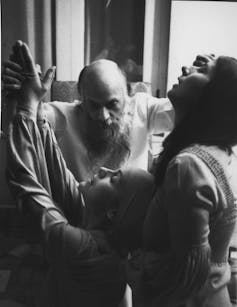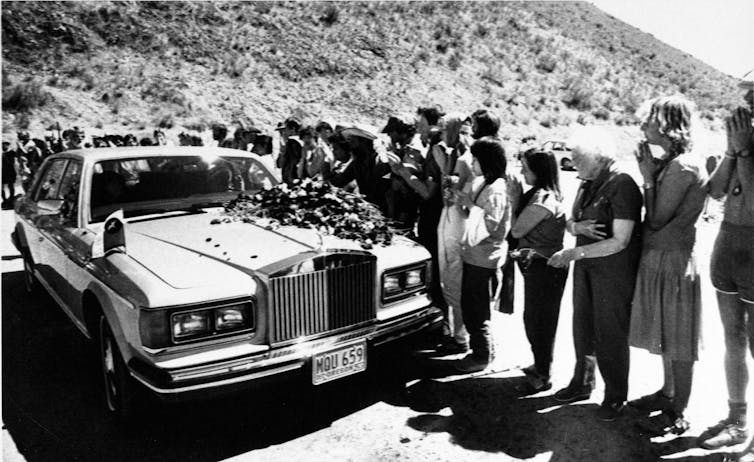what is there to do in rajneeshpuram today
Netflix recently launched a vi-part docuseries, "Wild Wild Country," about the controversial Rajneesh Motion that created a spiritual community on 64,000 acres of the former Large Muddy Ranch in Oregon. Back in the 1980s, as now, media focused on the group's outrageous acts, legal confrontations and alleged crimes.
The revelations that the community's guru, Rajneesh, made in 1985 were shocking. His personal secretary, Ma Anand Sheela, he said, had conspired with a small circle of well-nigh 24 people to kill land and federal officials, attempted to command a county election by busing in homeless people to vote and poisoning salad confined in the canton seat, and deliberately escalated tensions with outsiders. Sheela and some of her core were later charged and sentenced for state and federal crimes. Only many devotees told me and other researchers that they were unaware of the extent of her crimes and misdeeds until she left Rajneeshpuram. Neither was I.
As a scholar of gender and culling spiritual movements, I visited Rajneeshpuram x times before it airtight downwards completely early on in 1986 and talked with about 100 men and women who lived there. Although I was sometimes monitored, no one interfered with my research.
Away from the Netflix series' dramatic story, what devotees told me and what I observed adds another dimension to popular conceptions of the short-lived communal urban center.
Rajneeshpuram, Oregon

In 1981, later on running into problems with the Indian government, Rajneesh closed his ashram in the urban center of Pune in central India and invited devotees from all over the world to bring together him to create an extraordinary community in central Oregon. Some Rajneeshees bought houses in the closest boondocks, Antelope. Most, however, journeyed for another 19 miles on the winding mountain roads that led to the the plateau where Rajneeshpuram rested. At its peak, the communal city housed well-nigh ii,000 devotees.
Women and men labored together around the clock, constructing a huge meditation hall and an open-air mall with restaurants, clothing boutiques and a shop that sold hundreds of books and videotapes by and about Rajneesh. They as well created a private airport, a hotel, living quarters and a sparkling artificial lake.
The devotees belied pop stereotypes of passive, hands manipulated spiritual seekers. 2-thirds of Rajneeshpuram'southward residents had four-year college degrees and/or had previously pursued lucrative career paths.
These women and men talked with me near their experiences and life histories. Most men, for case, felt that they had personal relationships with their guru, fifty-fifty when they had never met him. They also emphasized how Rajneesh helped them access their hidden intellectual and emotional strengths.
This was interesting, only with each visit, my attention increasingly turned to women in their 30's and forty'southward whose incomes and educational attainments far exceeded the national average.
Accomplished women
50-four percentage of Rajneesh's devotees were women. Many had abandoned relationships, successful careers and occasionally young children in order to create a utopia around their spiritual leader. In our conversations, they disclosed that they followed Rajneesh to Oregon considering they felt that he had transformed their lives, and they wanted to go on to feel the love and affidavit that they received from their powerful protector.
Every woman that I interviewed at length had been influenced by the feminist move of the 1970s and hoped for full economic, sexual and social equality. They wanted to live very differently from their housewife mothers. However, they were deeply disappointed when they still felt anxious and lonely despite the coin and recognition that they received from their careers. They told me that they had felt forced to choose between successful careers and fulfilling marriages. They lost with either choice.
Ane devotee, who afterwards made a fortune in currency trading, told me that she had to driblet out of the university and her premedical studies when she married. She said, "It was sort of a Jewish ethic. Women were wives and mothers, they weren't doctors."
But Rajneesh asserted that women could succeed in every endeavour as well every bit or amend than men. He applauded loftier levels of accomplishment and too emphasized the importance of traditionally feminine traits like intuition and emotional sensitivity for both women and men. He told women that they could and should integrate their personal and professional lives. He said,
"It is for the edification of both human and woman that the woman should exist given every freedom and equal opportunity for her individuality."
At Rajneeshpuram, accomplished women were nearly always assigned to jobs similar to their old ones. For instance, psychologists led personal growth groups, attorneys staffed the legal department, urban center planners and architects designed roads and buildings, and writers and professors worked at the Rajneeshpuram newspaper, "Rajneesh Times." Devotees described laboring aslope people who shared their ideals and cared most feelings along with productivity.
An chaser with a caste from an aristocracy university discussed the joy of working with supportive friends and playing together at the end of long shifts. She said:
"We all say around here that work is our meditation. I feel really practiced…..Nosotros're sort of in this together."
Why women stayed

The guru himself may accept retreated into private meditation, delegating all organizational decisions to Sheela, but devotees nevertheless believed that he watched over them. Every adult female and human wore a locket with Rajneesh's movie and used the new Indian proper noun that he had bestowed on them. They broke into joyful tears when they lined Rajneeshpuram'due south main road to bow and place roses on the guru'due south Rolls Royce every bit he drove by each afternoon.
In September of 1985, according to media reports, the guru privately confronted Sheela about some of her crimes. She decamped to Germany, and Rajneesh once once more started his lectures. He informed devotees that his physician had told him almost her autocratic leadership and the movement'south mounting debts. He publicly condemned Sheela for masterminding scores of crimes and cooperated with state and federal authorities who wanted to auscultate Sheela and her cadre.
Devotees seemed to be thrilled to hear him speak once more than, although most told me that they wondered most Rajneesh's claims of total ignorance about Sheela's activities. I saw people protestation confronting Sheela and cheer when her official robes were tossed into a burn down. They celebrated when new movement leaders burned thousands of copies of "The Book of Rajneeshism" that Sheela designed. However, for months later the stunning disclosures, devotees that I interviewed even so believed in their guru.
For a fourth dimension, almost all of the women who responded to my mailed questionnaires in 1985 and 1997 or whom I kept in bear on with informally tried to sustain their faith.
Former style model Veena, for example, was victimized past Sheela because of her part as Rajneesh's personal seamstress and her room in his compound. Notwithstanding, Veena continued to trust the guru throughout her ordeals. In 2008, when I talked with her at length in England, she was as enamored with Rajneesh and her old Oregon comrades as she had been in 1981, when she guided well-known journalist Frances FitzGerald around Rajneeshpuram.
No affair how shocked or damaged they were, devotees did not quickly abandon the close friends or spiritual practices that had transformed their lives. However, in response to the 1997 follow-up survey, very few said that they notwithstanding believed in Rajneesh, or Osho, as he later came to exist known. Nevertheless, they looked back on their Oregon experience fondly.
One woman left the motility after a year considering she grew increasingly disgusted by Rajneesh's revelations, but in 1997, she still remembered central Oregon fondly. She said:
"No regrets. Some understanding of the human condition."
Most of the accomplished women returned to their old professions or transitioned to new ones. Their years at Rajneeshpuram had affirmed the importance of both work and honey, and they had learned that it was possible to enjoy both. As their survey responses showed, they were certain that they left the communal city with new abilities to office anywhere in the world.
Source: https://theconversation.com/i-did-research-at-rajneeshpuram-and-here-is-what-i-learned-89846
0 Response to "what is there to do in rajneeshpuram today"
Postar um comentário